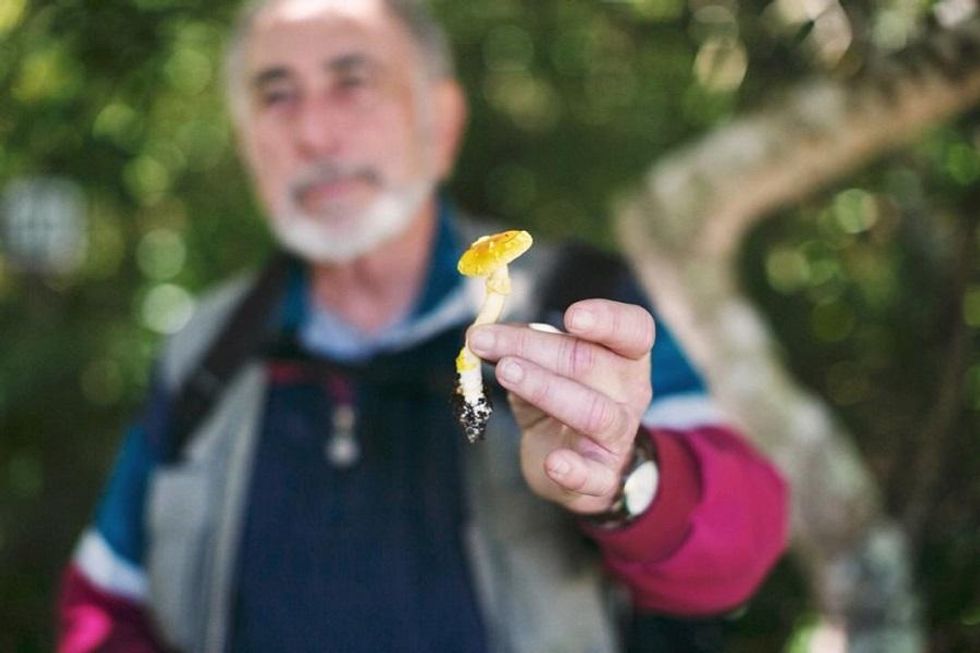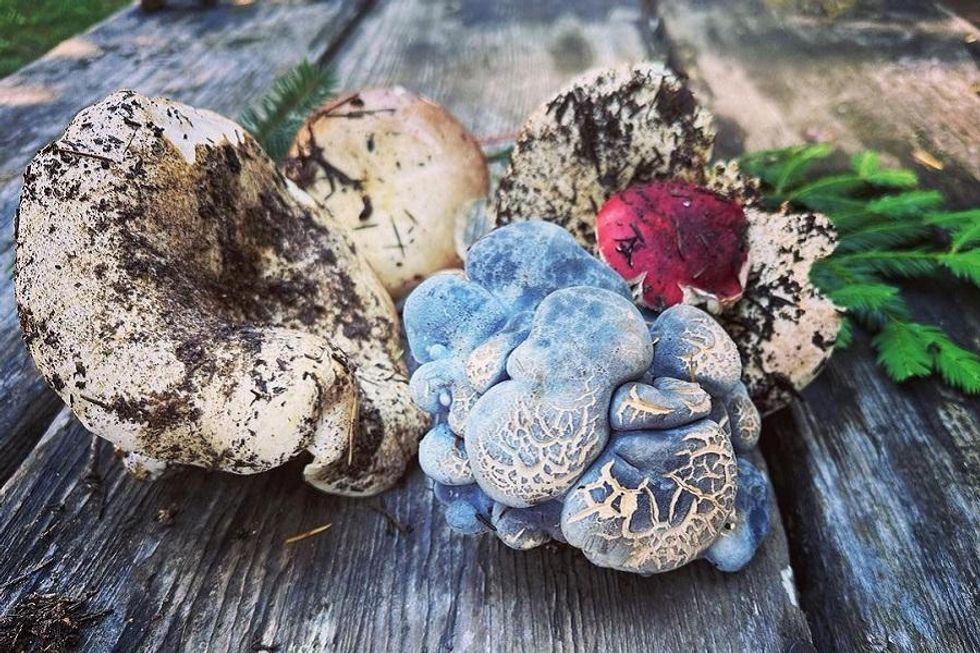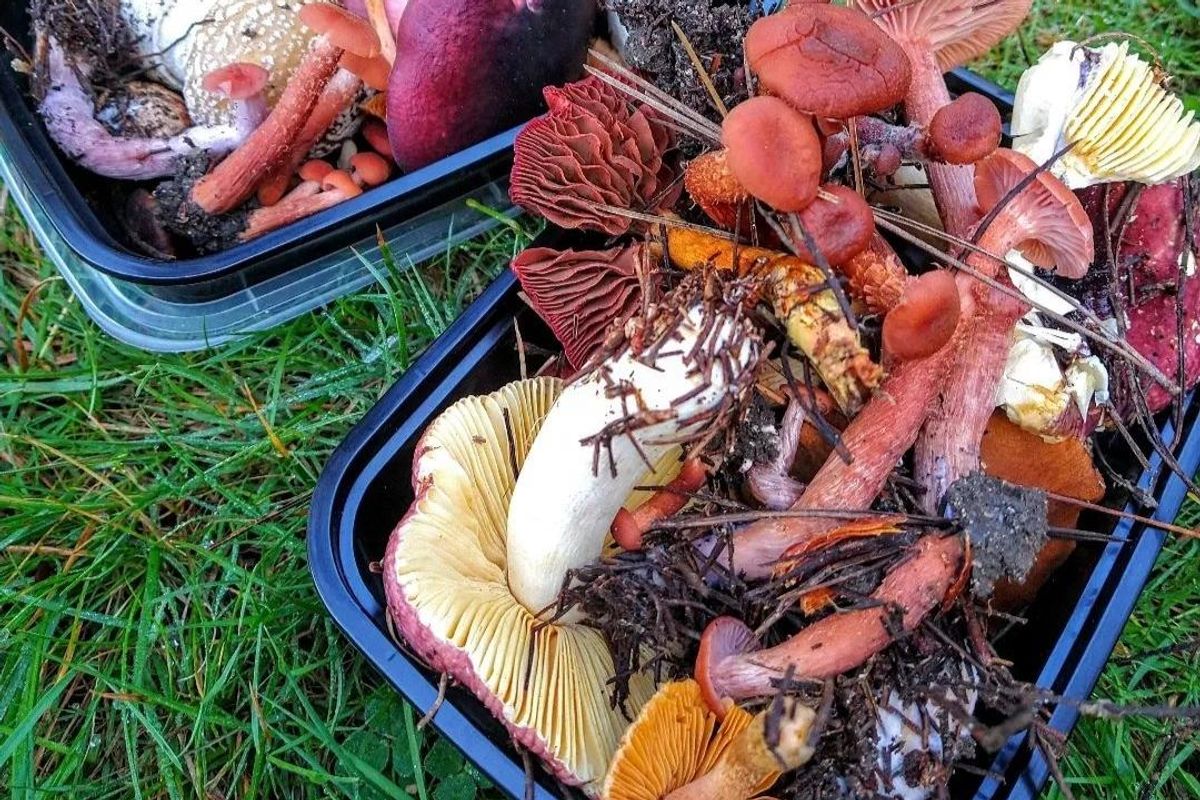With mild winters and a wide range of ecosystems, Northern California is one of the best places in the country for foraging wild foods.
The coastal region between Mendocino and Marin, in particular, is known for a massive mushroom bounty that can include everything from morels and chanterelles to maple-syrup flavored candy caps. But don’t just focus on the fungi. Edible seaweeds, fruits, nuts, and greens are also available for taking—if you know where to look.Foraging Classes, Guided Tours, and Forays

ForageSF hosts foraging classes from the Santa Cruz Mountains to the Sierra.
(Courtesy of @foragesf)
ForageSF
Marin and Sonoma counties are home to some of the richest mushroom-hunting grounds in North America. ForageSF guide Patrick Hamilton has more than 40 years experience foraging for fungi, and will teach you everything you want to know during his three to four hour class ($120-135). You'll hunt morels, black trumpets, hedgehogs, and more but, most importantly, you'll learn how to distinguish a savory chanterelle from poisonous varieties. Classes are available in Marin, Sonoma, and the Sierras. Colleague Maya Elson mans a similar two-hour class in Santa Cruz ($120-135). As an equal opportunity plant-harvesting outfit, ForageSF also offers classes on gathering seaweed in Sonoma and San Mateo counties, and edible and medicinal plants throughout the Bay Area. // foragesf.com
Sonoma County Mycological Association
The mushroom-curious will love the Sonoma County Mycological Association’s (SOMA) meetings, which host experts dropping knowledge about the mystery and magic of fungi monthly. Go deeper into the fungi favored by the group at regular wild mushroom forays at Salt Point State Park ($20.adults, free for kids under 16). The monthly events are led by foraging experts and typically include a potluck-style lunch. If you really catch the mushroom bug, check out SOMA’s Wild Mushroom Camp, a four day event in January. // somamushrooms.org
Sea Forager
Mushrooms aren’t the only delicacy intrepid harvesters have access to in the Bay Area. In one of Sea Forager’s coastal fishing and foraging classes you’ll learn how to “poke pole” for monkeyface eels, how to catch rock crabs, and where to find edible seaweed. Tours ($75/person) run two-and-a-half to three hours. // 1 Yacht Rd. (San Francisco), seaforager.com
HarvestWild
Shasta County adventure outfitter HarvestWild presents regular half-day clinics that teach participants the basics of identifying, gathering, and preparing wild and edible foods. Choose from a variety of topics including acorn processing ($80), mushroom picking ($150), and field-to-jar blackberry jam ($120). For a shorter introduction to harvesting wild plants, start with HarvestWild’s guided nature walk ($50), instead. The group also hosts guided hunting and fishing events, and virtual and in-person wild game cooking classes. // harvestwild.com
Mountain Sea Adventures
Outdoor adventure guide Caitlin Wild founded Santa Cruz’s Mountain Sea Adventures to help others connect with nature. She hosts regular Edible and Medicinal Wild Foods Walks ($75/adults, $45 kids 6-12, under 6 free) right from the town’s Westside, hiking through forests and fields teeming with natural bounty. Learn how to identify what’s good, and techniques for sustainably harvesting them, on the two-and-a-half hour, two mile hike. For more intensive fungi-focused foraging, keep an eye out for her occasional Mushroom & Plant Forage events. The next six hour foray takes place in Felton on December 17. // mountainseaadventures.com
Foraging Edible Plants on Your Own
You don’t necessarily need a guide to forage for food in Northern California. With a good manual on edible plants, even beginners can harvest native delights like dandelion greens, raspberries, and sweet fennel.
If you’re new to the foraging game though, don’t mess around with mushrooms. Fungi are masters at masquerading as edible mushrooms, and one wrong choice could be deadly. We highly recommend educating yourself first in a class or on a tour and backing up your new-found knowledge with a guide to mushroom identification.
The Dos & Don’ts of Foraging
- DO pick up a guide book to identify dangerous plants and mushrooms.
- DO check park rules before heading out to forage. Some parks require permits or have limits on how much you gather.
- DON’T head to a California state park to harvest wild plants. It is illegal in almost all of them.
- DON’T collect more than you need. Over-foraging can upset the balance of delicate ecosystems.
- DO research the best seasons and conditions for finding the plants and mushrooms that interest you before heading out.
- DON’T eat any wild mushrooms without consulting a foraging expert.
Where to Forage for Edible Plants in Northern California

Mushrooms harvested at Salt Point State Park in Sonoma
(Courtesy of @scott_sorenson)
Jackson Demonstration State Forest
The Mendocino Coast is prime habitat for a wide variety of edible mushrooms. At the Jackson Demonstration State Forest, foragers have more than 48,000 acres to hunt for species like golden chanterelles, crocodile agaricus, and “the prince” (Agaricus augustus). Permits are required for all mushroom gathering ($20). // 802 N. Main St. (Fort Bragg), fire.ca.gov
Point Reyes National Seashore
Mushrooms are abundant at Point Reyes National Seashore between the first fall rains and early spring (not surprisingly, they’re most abundant during wet years). Gatherers can take home two gallons per person per day, along with up to two quarts of wild blackberries, raspberries, thimbleberries, gooseberries, salmonberries, huckleberries, or apples. No permit required. // 1 Bear Valley Rd. (Point Reyes Station), nps.gov/pore
Salt Point State Park
Sonoma’s Salt Point State Park is one of the few in California that allow foraging. The best fungi, including the Alice-in-Wonderland-like Amanita muscaria, pop up about a week after heavy rains across more than 20 miles of hiking trails adjacent to the rocky coast. You can collect up to three pounds of mushrooms per day without a permit. // 25050 Hwy 1 (Jenner), parks.ca.gov
Sequoia and Kings Canyon National Park
One of the state’s most majestic ecosystems, Sequoia Kings Canyon has a wealth of edible plants in the summer and fall. Visitors are allowed to collect up to one pint per person per day permit-free, including fruit like blackberries, elderberries, and strawberries; mushrooms like morels; and watercress and wild onions. Only cutting, not pulling out the plant by its roots, is permitted. // 47050 Generals Hwy (Three Rivers), nps.gov/seki





















